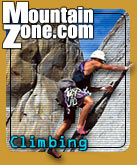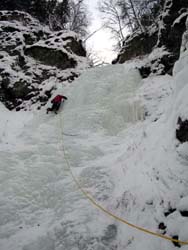
|
Alaskan Grade December 29, 2003 Pages »1 2
Day 2: Dec. 1, 2003 Walking along the canyon bottom, it seemed there was more open water than before. We came to a spot where we'd crossed the creek only a few days ago, but saw an open area 20' by 20'. As we stood there mildly agape and deciding how to tackle this challenge, we heard a muffled rumble to our left and turned just in time to see another section of ice 20' by 8' collapse into the river. At this point we decided to alter our approach trajectory and walk upriver among the willows until we found a more stable area to cross. Not knowing the water's depth nor wishing to find out empirically, we decided to don our harnesses and tie in with kiwi coils in anticipation of an unwelcome dunk! Gingerly passing over the creek with arms outstretched like tightrope artists, we reached the other bank holding our breath, but without crisis. Literally walking on thin ice, we passed the landmarks from last week and we saw "Ripple" (WI3) again. Today being much warmer, it was dripping slightly down the middle of the heavily columnated first pitch, but still quite solid. It was all ours today, and we could hardly get geared up fast enough in our enthusiasm to get on route. While putting Pete on belay, I noticed the ice below my crampons was quickly getting slushy. Since I was standing atop a frozen creek which had been collapsing elsewhere, I halted him before starting up and hastily got closer to the base of the frozen waterfall. Whenever possible, I prefer to stand back and let the chunks and chips fall in front of me. However, with the possibility of me breaking through the ice and pulling Pete off the face in the middle of a lead, I had to forego this small comfort and let my Petzl helmet take some ice knocks. Pete started up the first pitch of the icefall. His ice tools made hollow but solid sounds as they found concavities to sink into. These areas are found initially by visual examination, then tried out with a definitive swing. The right side of the fall provided a clear and direct line to the top of the pitch where two bolts were placed into some sound rock. Soon Pete had established himself there and began to belay me up.
Working my way up, the holes where Pete placed his ice tools were too far apart. As I created new ones, the ice would "dinnerplate" off in large discoid shapes. The mischieviously satisfying sound of china breaking below echoed back up to me on the route, the only other thing audible in this cold canyon besides our climbing. More often though, the ice crumbled apart where a concentration of air bubbles had accumulated, or where the surface had slightly melted. This surface ice insulated deeper layers, leaving better material below. Breaking up the surface ice with a couple of unsuccessful plants, I went right back for the deeper ice where I found a reassuring "stick." As with rock climbing, the natural tendency to pull yourself up with your arms is a recipe for early fatigue and poor technique. I reminded myself to trust crampon placements and focus on careful footwork as I crept upward, conserving energy for the next pitch. The second pitch started out with a low angle ramp of compact snow, then changed quickly into pure water ice. Leaning back on my personal anchor belaying Pete as he climbed up the left side I heard two more areas of the creek below give way. I wondered what our hike out would be like, and hoped the packs we'd left below were still above water. After placing two ice screws, I noticed his speed drop and movements become more delicate. The last ice screw he placed seemed the most tenuous. He disappeared over the bulge at the top and was soon bringing me up. The first half was thick, tolerating relatively carefree swings and kicks to make quick progress. Upon reaching the second half, I understood why Pete had slowed up. It was much thinner. Here I had to rely on hook angle, balance, and finesse rather than the mental security of seeing and feeling my ice tool penetrate into the ice. Using hook angle requires finding an area which visually appears like a ledge or hole, over which the nose and teeth of the ice tool can be hooked. Instead of piercing the ice, it rests on a ledge. Instead of crampon placement with a kick, a very small tap or perhaps just standing on a small flat area with the front two points has to suffice. Making this transition never fails to raise my heart rate. The prospect of swinging or kicking too hard and eliminating ice material to climb up on forces an attitude of delicacy.
We packed up, gulped down the last of the tea kept warm in an insulated Sigg bottle, and headed out after another victorious day. Despite hearing the crash of the creek opening up throughout the day, our path out was luckily in the same condition. I offered a mock prayer of thanks to the Gods of Plastic Boots for doing their best to keep my feet warmer for longer. We left Thunderbird Canyon preparing for the most dangerous part of our day - driving home on Alaska's icy highways - but knowing we'd definitely return again.
-- by Kim Chapman
|
||||||||||||||||

